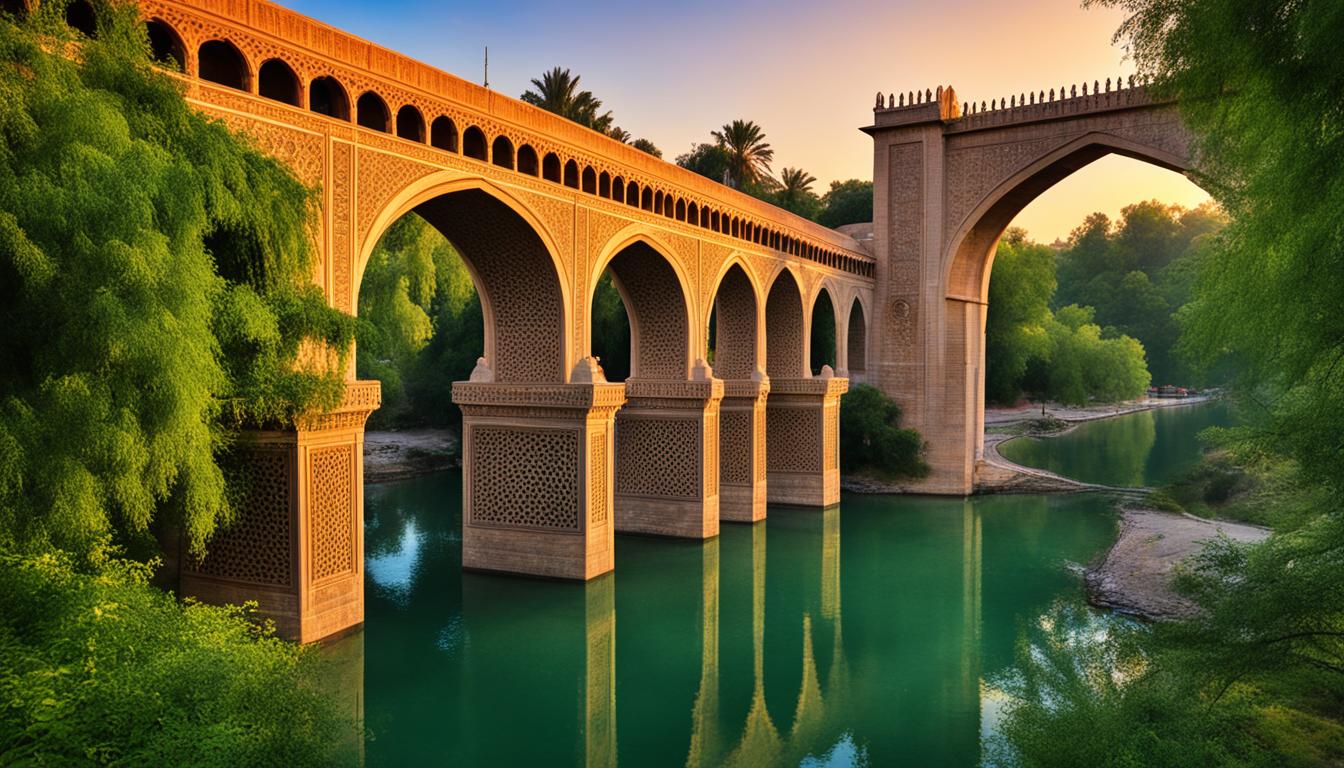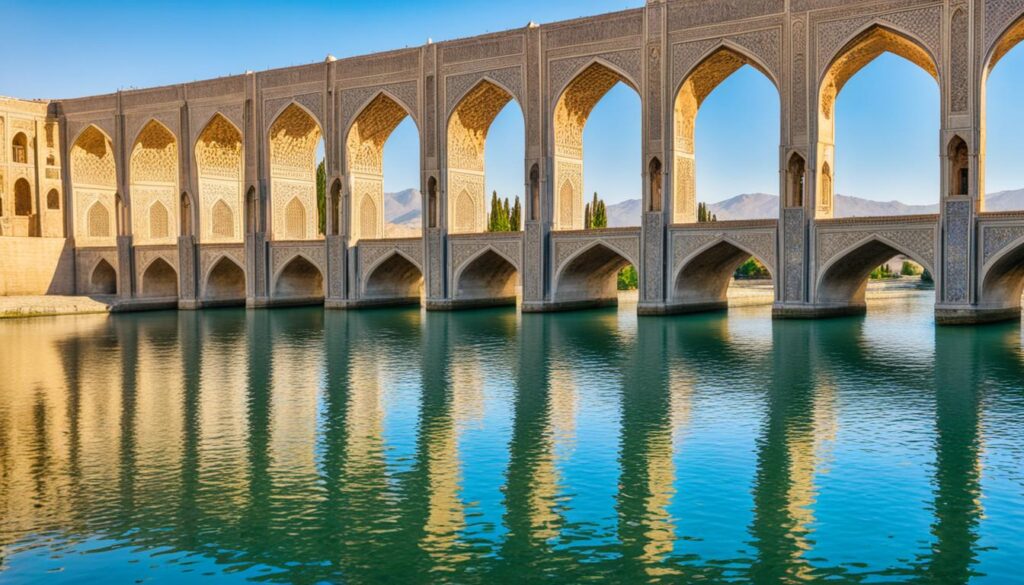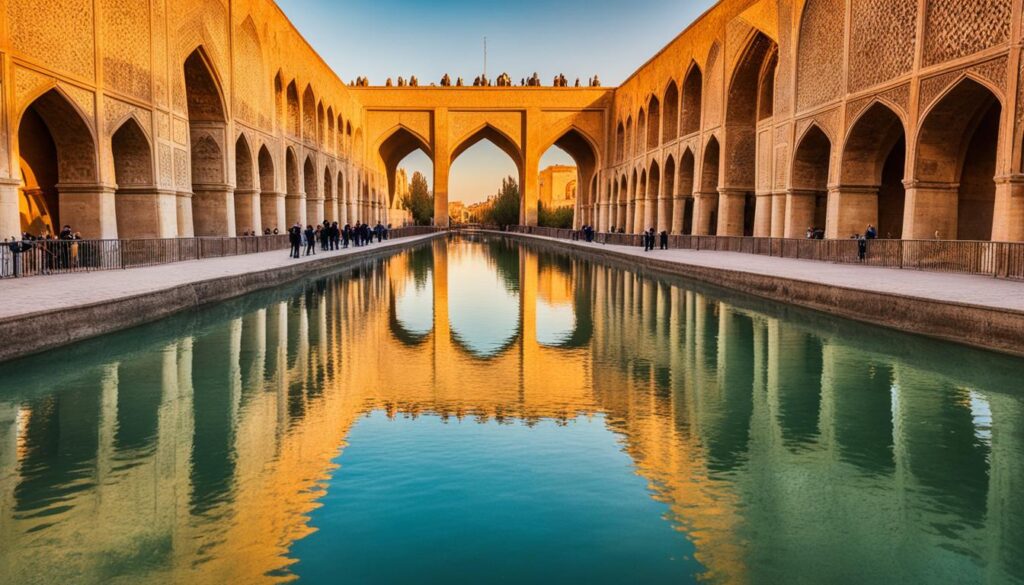
Explore the Splendor of Khaju Bridge in Isfahan
Did you know that Khaju Bridge in Isfahan, Iran, is more than just a bridge? It’s a historical Persian bridge that has stood strong over time. This grand structure highlights the architectural skills of the Safavid dynasty. It’s also a key attraction in Isfahan.
Khaju Bridge is known for its beautiful design and historical value. It has earned a spot as a UNESCO World Heritage site. People from around the globe come to see its beauty. This bridge gives us a peek into Iran’s rich culture. It’s a must-visit for those in Isfahan.
We’re going to explore the history, special features, and importance of Khaju Bridge. Find out why it’s a famous symbol of Isfahan’s architectural greatness.
A Brief History of Khaju Bridge
The Khaju Bridge is an amazing piece of architecture from the 17th century. It was built during the Safavid dynasty’s peak. It shows how grand things were back then. This bridge in Isfahan, Iran, did two jobs: it was a bridge and a dam.
Shah Abbas II was behind its creation. He was a well-loved leader of the Safavid era. He saw the need for a bridge. It would connect two sides of a river and help with irrigation.
In the 19th century, the bridge got some updates. This happened under Naser al-Din Shah Qajar. These changes made the bridge stronger and helped it control the river’s flow.
Now, Khaju Bridge is a historical site protected by UNESCO. Visitors love its stunning architecture and deep history. It shows off the Safavid dynasty’s skills in engineering and art.
Look at the image above. The Khaju Bridge tells the story of Isfahan’s glorious past. It attracts those who love history and architecture. Its grand look and detailed design spotlight Iran’s rich cultural background.
The Architecture of Khaju Bridge
Khaju Bridge is an amazing example of engineering and a symbol of the Safavid dynasty’s skill. Its balanced design and special features draw in those who see it.
The bridge has two levels, each with its own role. The lower level is a dam that controls the river’s flow. It has sluice gates to manage water levels and keep the area stable.
At the top level, there’s a stunning central pavilion. It’s filled with beautiful tilework and paintings. This place is for people to meet, enjoy social events, and see incredible views of Khaju Bridge and its surroundings.
“The symmetrical design and thoughtful integration of the dam and central pavilion showcase the architectural brilliance of Khaju Bridge,” says Mohammad Ali Yazdani, an expert in Persian architectural history.
The bridge’s balance is not just nice to look at but it also makes it sturdy. Thanks to this harmony, Khaju Bridge can last for hundreds of years, beating both time and the Zayanderud River’s force.
Khaju Bridge – A Harmonious Blend of Form and Function
| Design Feature | Description |
|---|---|
| Symmetrical Architecture | The bridge’s symmetrical design adds to its aesthetic appeal and structural stability. |
| Two Levels | The bridge consists of two levels, with the lower level functioning as a dam and the upper level housing the central pavilion. |
| Central Pavilion | The central pavilion, adorned with intricate tilework and paintings, serves as a gathering place for social activities while offering panoramic views. |
| Regulating Dam | The lower level of the bridge acts as a dam, allowing for the regulation of the river’s flow and maintaining the stability of the surrounding area. |
Unique Features of Khaju Bridge
The Khaju Bridge is a stunning piece of architecture with features that draw in many visitors. Let’s dive into the aspects that make this historic Persian bridge so grand.
Stone Lions Symbolizing Bakhtiari Tribal Warriors
Stone lions stand on both sides of the Khaju Bridge. They honor Bakhtiari tribal warriors. Not only do these lions enhance the bridge’s beauty, they also symbolize strength and courage.
Bridge Foundations Strengthened by Water
The base of Khaju Bridge gets stronger with water. This clever design keeps the bridge stable, even against strong currents.
Candle-like Patterns through Bridge Openings
A special view of Khaju Bridge shows a candle-like pattern. This effect creates a magical feeling at sunset.
Eagle-like Silhouette from Above
From above, Khaju Bridge looks like an eagle spreading its wings. This view shows off the bridge’s impressive design.
Curved Ceilings Enhancing Acoustic Phenomenon
Khaju Bridge has curved ceilings for a special reason. They let people talk across the bridge with clear sound.

Discover Khaju Bridge’s beauty. Enjoy its stone lions, strong foundation, and unique candle-like patterns. See the bridge’s eagle-like shape from above and experience the special acoustics. It’s truly a remarkable place.
Khaju Bridge as a Gathering Place
Throughout history, Khaju Bridge has been a key spot for locals in Isfahan. It has been the scene of many social and cultural events, making it a lively center of community life.
The bridge has hosted everything from festivals to music shows. Its beauty and history draw people together. They come to share experiences and connections.
“Khaju Bridge is more than just a bridge; it’s a piece of Isfahan’s history and culture,” Ahmad, a local, explains. “It has seen many gatherings and celebrations, creating unforgettable memories.”
“Khaju Bridge is a place filled with joy and unity,” says Zahra, a visitor. “Listening to traditional music, hearing people laugh, and seeing beautiful views made it unique.”
Khaju Bridge still draws people with its charm and historical value. Both locals and tourists enjoy its stunning views and lively atmosphere. It is a cultural landmark, ideal for walks or cultural events.

Events and Cultural Activities
Khaju Bridge serves as a venue for many cultural occasions. Its architecture is perfect for performances of music, dance, and stories. This setting offers a special cultural experience.
The scenery around the bridge, especially with the river below, makes it a beautiful spot for events. It hosts celebrations like Nowruz and traditional music concerts.
At these events, people blend, enjoying culture amid the bridge’s historic beauty. Music, art, and history converge, making Khaju Bridge an exceptional place to meet.
Connecting Past and Present
Khaju Bridge links today’s people with Isfahan’s storied past. It acts as a monument of collective memory, more than just a structure.
Its role as a social center has shaped Isfahan’s culture. It showcases the community’s resilience and creativity. It also celebrates the area’s diverse cultural heritage.
| Cultural Activities | Historical Significance |
|---|---|
| Celebrations | Khaju Bridge has witnessed generations of celebrations, creating lasting memories for the community. |
| Festivals | As a gathering place for festivals, Khaju Bridge has become an integral part of Isfahan’s cultural fabric. |
| Musical Performances | The bridge’s acoustics amplify the sounds of music, turning every performance into a mesmerizing experience. |
Best Time to Visit Khaju Bridge
The best time to see Khaju Bridge is at sunset. It’s simply magical. As the sun goes down, the bridge shines in a golden light. This light makes the bridge look stunning.
The bridge’s reflection on the Zayanderud River is beautiful at sunset. It looks like the bridge is mirrored on the water. This creates a peaceful and lovely view.
At sunset, the sky around the bridge fills with color. You’ll see orange, pink, and purple. These colors make the bridge even more beautiful.
“Visiting Khaju Bridge during sunset is like stepping into a fairytale. The bridge’s illumination and the captivating colors of the sky create a truly magical atmosphere.” – Local Isfahan Resident
In the evening, Khaju Bridge is a gathering spot for locals. They come to enjoy the view and each other’s company. It’s a great chance to experience Iranian culture and hospitality.
To see Khaju Bridge’s beauty at its best, visit at sunset. Once you see the bridge and the views, you’ll know why it’s the best time to go.
Khaju Bridge in Isfahan Sightseeing
If you’re exploring Isfahan, you can’t miss Khaju Bridge. This spot shows off the city’s rich history and stunning architecture. Along with Naghsh-e Jahan Square and the Jameh Mosque, it’s a key sight.
The mix of history, culture, and beauty at Khaju Bridge is something special. It’s a must-see for all visiting Isfahan. The bridge’s design and its setting are truly breathtaking.
“Khaju Bridge stands as a remarkable testament to the architectural wonders of Isfahan and its historical significance.”
Walking on Khaju Bridge takes you back in time. You’ll see the detailed work and ancient stones. It’s a walk through history.
The bridge offers amazing views of the Zayanderud River. It’s perfect for seeing sunrises or sunsets. Both photographers and nature lovers will find it stunning.
Beyond Sightseeing: A Unique Experience
Khaju Bridge is more than a sight. It’s where locals and visitors meet. You might hear Persian music or see people enjoying a walk.
Its central pavilion is a lively social spot. Here, you can meet others and dive into Isfahan’s culture. It’s full of life and heritage.
Make sure Khaju Bridge is on your list in Isfahan. It’s a place of beauty, history, and community. Don’t miss experiencing this attraction.
| Why Visit Khaju Bridge in Isfahan | |
|---|---|
| 1. | Experience the historical and architectural beauty of Isfahan |
| 2. | Enjoy panoramic views of the Zayanderud River |
| 3. | Immerse yourself in the vibrant atmosphere of a social gathering place |
| 4. | Explore the charm and allure of Isfahan’s top tourist attractions |
Conclusion
The bridges in Isfahan, like the famous Khaju Bridge, are more than just ways to cross water. They are key historical sites that show off the city’s rich culture. These structures link the past to the present, making a deep impact on those who see them.
Khaju Bridge stands out for its incredible design and historical value. It highlights the greatness and architectural wonders of Isfahan. When people explore Khaju Bridge, they dive deep into the history and beauty of Isfahan’s landmarks.
FAQ
Is Khaju Bridge a famous tourist attraction in Isfahan?
Yes, Khaju Bridge is a popular spot in Isfahan. It’s famous for its rich history and beautiful architecture.
What is the historical background of Khaju Bridge?
The Safavid dynasty built Khaju Bridge during Shah Abbas II’s reign in the 17th century. In the 19th century, it was renovated under Naser al-Din Shah Qajar.
How is Khaju Bridge designed?
Khaju Bridge has a symmetric design with two levels. The lower level helps control the Zayanderud River’s flow. The top level features a pavilion, decorated with tiles and paintings.
What are the unique features of Khaju Bridge?
The bridge has stone lions at both ends, representing Bakhtiari warriors. Its structure gets stronger with water.
From a certain view, the bridge looks like a candle pattern. From above, it seems like an eagle spreading its wings. The design lets people hear each other from opposite sides.
How has Khaju Bridge served as a gathering place throughout history?
Khaju Bridge has been a center for social and cultural events. It has seen celebrations, festivals, and music, bringing the community together.
When is the best time to visit Khaju Bridge?
Sunset is the perfect time to see Khaju Bridge. The lighting creates a magical scene. It offers beautiful views of the Zayanderud River and the bridge’s reflection.
Is Khaju Bridge a must-visit attraction in Isfahan?
Definitely, Khaju Bridge is a must-see in Isfahan. It shows the city’s rich history and stunning architecture, along with other landmarks.
What is the significance of Khaju Bridge in Isfahan sightseeing?
Khaju Bridge is a key site in Isfahan for tourists. It adds to Isfahan’s charm, showcasing historical and cultural sights.
Source Links
- https://kentaltravel.com/blog/khajoo-bridge/
- https://www.tappersia.com/the-bridges-of-isfahan/
- https://matinabad.com/en/things-to-do-in-isfahan/

Leave a Reply